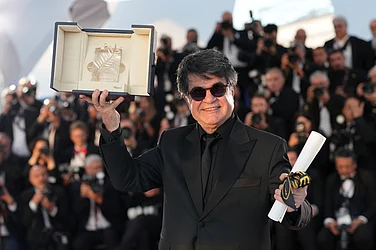Is he a God? Is he a concept? Is he truth? Is he beauty? Is he consciousness? Is he a representation of the phallus? Is he a destroyer? Is he the lord of dance? Is he the only primordial God? Is he the holy trinity? Or is he the God of the Dalits?
Shiva is all of the above and more. The Nirvana Shatakam by Adi Shankaracharya symbolises Shiva perfectly. I am citing two verses, the opening and the closing, of the six-verse Nirvana Shatakam composed by the iconic Adi Shankaracharya in the 8th century. The shlokas read:
Mano-buddhyaha kāra-cittāni nāha na ca śrotra-jihve na ca ghrāna-netre|
na ca vyoma bhumir na tejo na vayu cid-ānanda-rūpah sivo’ham śivo’ham ||
(I am neither the conscious nor the unconscious mind, neither intellect nor ego, neither the ears nor the tongue nor the senses of smell and sight, neither ether nor air nor fire nor earth. I am Consciousness and Bliss.
I am Shiva! I am Shiva!)
Aham nirvikalpo nirākāra-rūpo vibhutvāc
ca sarvatra sarvendriyān.ām|
na casangatam naiva muktir na meya
cidānanda-rūpah śivo’ham śivo’ham||
(I am without thought, without form. I am all-pervasive; I am everywhere. I am neither detachment nor liberation nor anything that could be measured by all the senses. I am Consciousness and Bliss. I am Shiva! I am Shiva!)
My own deep and continuing engagement with Shiva started more than 35 years ago, when I chose to work on a leela murti of Shiva, the ardhanarishvara image in Indian art, thought and literature. Shiva as ardhanarishvara literally translates into the Lord who is half woman. As ardhanarishvara, Shiva is also an icon of perfection, where Purusha and Prakriti, Ying and Yang, are in a perfect celestial balance. Through the image and study of ardhanarishvara, a new realm opened for me. Shiva is the mahayogi, the ascetic, and the mahabhogi, the complete enjoyer of life. Shiva is always in a balancing moment of a conflict, a difficulty, a contradiction. He is the God to be sought in trouble.
Till then, I only knew of Shiva as the God to whom young, unmarried women fasted for 16 Mondays of saawan or the monsoon to get the perfect husband, embodied by the perfect form of Shiva. I grew up being a complete devi bhakta, as Mahalakshmi, Mahakali and Maha Saraswati were my presiding deities. As I went deep into my study and exploration of Shiva, I slowly started entering a terrain which was quite different from that of the worship of the Eternal Goddess, the devi or maa as I know her. I learnt that the Shakti of Shiva was the devi herself. I also believe that Shiva can be both Shiva and Shakti, so powerful is the concept of the image itself.
In popular culture, Amish Tripathi has taken Shiva to another level through his book, The Immortals of Meluha, a trilogy. The cool God of modern times is Shiva. Wild, wide-eyed, bhang-loving, with his dread locks, “Bum Bum Bhole”.
There is yet another side to Shiva. Rebellious and subversive, he is unclean, unkempt, with his army of scruffy ganas. He also becomes the presiding deity of the indigenous, of the chandalas and the mlecchas, living in the graveyards, a wandering nomad who overpowers the powerful Brahmins.
Shiva the “cool” God of present times has more than a thousand manifestations. Living with Shiva in practice, and from research into antiquity to now, I have cherry-picked some of my favourite manifestations. The many forms of Shiva traverse different mediums and different geographies, replete with a thousand and one stories, which illustrate and represent the innumerable incarnations of Shiva, from Veerabhadra to Bhairava, from Pashupati to Sadashiva and from the anthropomorphic emblem of the linga, especially the prominent 12 jyotirlingas. He has many sides to his form. He is also the wild God of power and ecstasy. His manifestations are many, from Rudra to Veerabhadra, from Mahadeva to Bhairava, and they all cross boundaries of caste, class and community. He is also the God of those who go beyond the pale of caste.
ALSO READ: Shiva In Mythology: Let’s Reimagine The Lord
The story of Rudra
Rudra, like Daksha, is a manasputra or mind-born son of Brahma. The mind-born child was a three-eyed boy, red and blue of colour, who immediately started crying in angry fits. “Why are you howling like this?” his creator asked him. “Because I don’t know my name,” he screamed.
“Well, then,” said Brahma, who could not think of anything better, “you shall be known as Rudra (Sanskrit rud to cry or howl).” After finding his name, the howler split into 11 persons, some dark and threatening, others light and benign.
The story of Harihara
Once, the Gods approached Vishnu because they were upset and at a loss to explain why the world was in such a mess. Vishnu in response told them that only Shiva could give them the answer. The dumbfounded gods followed the instructions, but still their vision was as though they were snow-blinded. “Oh, Jaganatha, Lord of the World,” they cried out, “Where can we find the trident bearer, that we might honour him?” Vishnu pointed at his chest and said, “He is in me, as I am in him; can’t you see?” As he spoke, he revealed his lotus heart and as its petals opened, unfolding the sacred linga. The gods hastened to worship it by pouring milk over it, covering it with vermilion, fragrant sandalwood paste, trifoliate bilva leaves, flowers, herbs and lotus blossoms, while chanting the names of Vishnu and Shiva. In their minds, however, they kept wondering how hari (Vishnu) and hara (Shiva) could be one and the same? Did not Vishnu have light, sattvic qualities, while Shiva had dark, tamasic qualities? Reading their thoughts, Vishnu took on Ishvara’s (Shiva’s) form. They could no longer tell the difference between the three-eyed God with the matted hair and cobra necklace and the other one with the chakra (disk) and seashell. Capitulating before the mystery, they all prostrated and worshipped him.

The story of Bhairava
Bhairava is the most terrifying form of Shiva the destroyer. Bhairava then roams in the graveyard and takes the form of a dog. In another interpretation, Bhairava is the wandering Shiva and is present in every Shakti Peeth (the Seat of Goddess) as well.
Shiva as the Dalit God
Shiva cannot be confined to the four walls of a temple and become the property and under the control of the Brahmin priests. In caste-ridden India, the priests of the temple kept lower castes away through rituals, which valorised purity. This begs the question: Is Shiva the sole property of Brahmins or is he a Dalit God?
Or does he transcend all barriers as we deconstruct our myths? We find the first a ppearance of Shiva as the icon denying the caste system.
Shiva has been also the God of those living in the margins, in the liminal spaces of caste and gender. He is Bad Deo, the Lord of the indigenous communities in Madhya Pradesh and worshipped there as a communal deity. As Pashupati, he is the lord of the pashus (animals).
Linga as marker of Shiva’s identity
Interestingly, Shiva is also worshipped in his anthropomorphic form, the linga, a phallic symbol. Despite that, the linga occupies the centremost position in a Shiva temple. This is clearly seen in temples from the Pallava period, where Shiva deities are placed a step lower than the linga. There are many kinds of lingas, but they are broadly divided into two categories, the movable chala-lingas and the immovable achala-lingas. Many subcategories exist within these; an important one being the mukhalingas, which can have a number of faces of Shiva emerging from the central linga. The chala-lingas are basically meant for personal worship and could be carried through journeys and pilgrimages.

It is believed that Ravan was a great Shiva bhakt and carried a golden linga with him for worship. The linga is always placed on a pedestal, known as the yoni patha, symbolising the union of the penis and the vulva, symbolising creation through celestial union. Ravan would place the golden linga in sand and would then perform prayers with incense and fragrant flowers. In the commentary to ‘Uttarakanda’, it is said “that the golden linga was intended for constant worship. He worshipped it from the desire of sovereignty. For it is prescribed in the tantra that a golden linga should be worshipped when any one desires sovereignty”.
The 12 pillars of light
Jyoti means radiance and linga means the mark of Shiva. The 12 jyotirlingas are the most important sites of Shiva worship: Somnath, Mallikarjuna, Mahakala, Parameswara, Kedar, Bhimashankar, Visvesa, Tryambaka, Vaidyanath, Nagesa, Rames and Ghumes. According to Hindu mythology, the world is divided into devas, asuras and mortals, where Shiva rules with his sacred phalluses. The three temporal worlds of the devas are pervaded by Shiva in the form of phalluses. However, the 12 jyotirlingas are spread in every region of the land. It is believed that at the sites of the jyotirlingas, Shiva showered his blessings with his reincarnation, and his sacred linga is a representation of his love towards the devotees. A prayer to these jyotirlingas, or even a mere sight of them, opens the path towards moksha—a devotee can get rid of his sins with daily prayers and offering to the jyotirlingas.
As stated above, the jyotirlingas are the most sacred of religious pilgrimages for the Shaivaites. In their lifetime, Shaivaites would try to ideally visit all the 12 jyotirlingas. Each pilgrim is on his or her journey to experience the touch and feel of the sacred phallus.
After the many myths, stories and research on the primordial God, Shiva, I am still wondering: who is Shiva?
(This appeared in the print edition as "Who is Shiva?")
(Views expressed are personal)
Alka Pande The writer is an academic and curator.

























